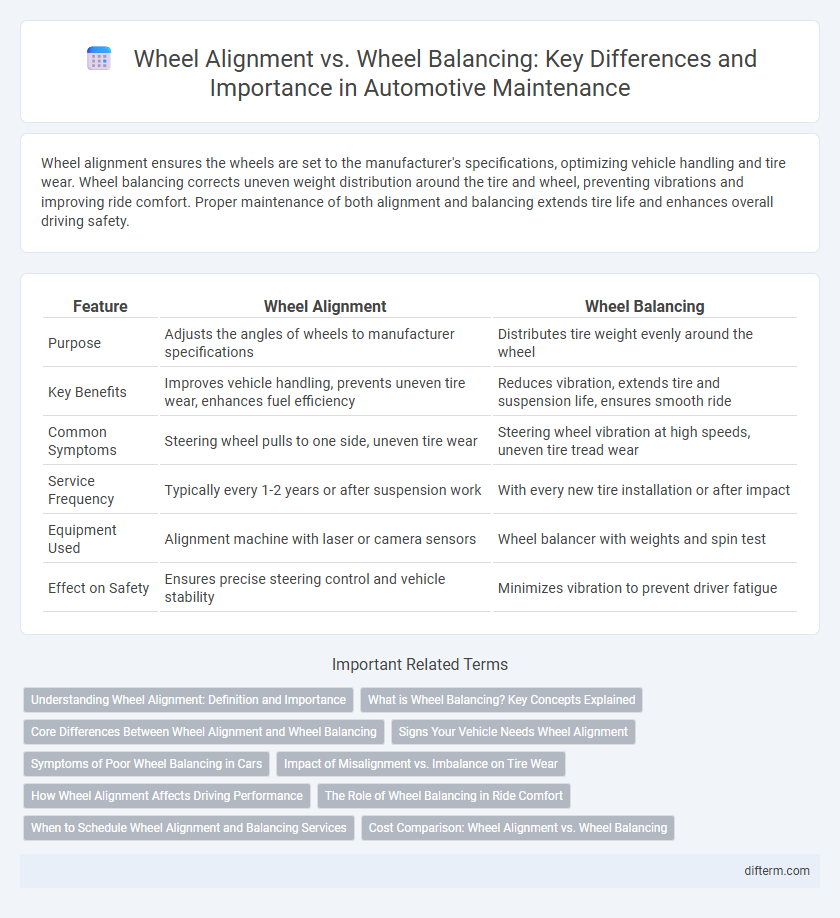Wheel alignment ensures the wheels are set to the manufacturer's specifications, optimizing vehicle handling and tire wear. Wheel balancing corrects uneven weight distribution around the tire and wheel, preventing vibrations and improving ride comfort. Proper maintenance of both alignment and balancing extends tire life and enhances overall driving safety.
Table of Comparison
| Feature | Wheel Alignment | Wheel Balancing |
|---|---|---|
| Purpose | Adjusts the angles of wheels to manufacturer specifications | Distributes tire weight evenly around the wheel |
| Key Benefits | Improves vehicle handling, prevents uneven tire wear, enhances fuel efficiency | Reduces vibration, extends tire and suspension life, ensures smooth ride |
| Common Symptoms | Steering wheel pulls to one side, uneven tire wear | Steering wheel vibration at high speeds, uneven tire tread wear |
| Service Frequency | Typically every 1-2 years or after suspension work | With every new tire installation or after impact |
| Equipment Used | Alignment machine with laser or camera sensors | Wheel balancer with weights and spin test |
| Effect on Safety | Ensures precise steering control and vehicle stability | Minimizes vibration to prevent driver fatigue |
Understanding Wheel Alignment: Definition and Importance
Wheel alignment refers to the precise adjustment of a vehicle's suspension components to ensure that the wheels are set to the optimal angles specified by the manufacturer, enhancing tire longevity and driving safety. Proper wheel alignment prevents uneven tire wear, improves fuel efficiency, and stabilizes vehicle handling, which are critical for automotive performance. Misalignment can cause steering difficulties, increased tire wear, and reduced overall vehicle control, emphasizing the necessity of regular alignment checks.
What is Wheel Balancing? Key Concepts Explained
Wheel balancing refers to the process of equalizing the weight distribution of a vehicle's tires and wheels to ensure smooth rotation and minimize vibrations. Imbalanced wheels can lead to uneven tire wear, steering wheel vibration, and decreased fuel efficiency, making wheel balancing critical for vehicle safety and performance. The process involves attaching small weights to the wheel rim to counteract heavy spots, improving ride quality and extending tire life.
Core Differences Between Wheel Alignment and Wheel Balancing
Wheel alignment involves adjusting the angles of the wheels to the manufacturer's specifications, ensuring proper contact with the road and preventing uneven tire wear. Wheel balancing focuses on distributing the tire and wheel weight evenly around the axle, reducing vibrations and extending tire life. Proper wheel alignment improves vehicle handling and fuel efficiency, while wheel balancing enhances ride comfort and reduces premature tire damage.
Signs Your Vehicle Needs Wheel Alignment
Uneven tire wear, steering wheel vibration, and the vehicle pulling to one side are common signs your vehicle needs wheel alignment. Misaligned wheels can cause poor handling and increased tire wear, affecting safety and fuel efficiency. Timely wheel alignment ensures optimal tire contact with the road, enhancing overall vehicle performance.
Symptoms of Poor Wheel Balancing in Cars
Poor wheel balancing in cars often causes vibrations in the steering wheel at higher speeds, uneven tire wear, and increased fuel consumption. Drivers may experience wobbling or shaking sensations, especially noticeable on smooth roads, impacting driving comfort and vehicle control. Addressing wheel balancing issues promptly helps maintain tire longevity and ensures optimal vehicle performance.
Impact of Misalignment vs. Imbalance on Tire Wear
Misalignment causes uneven tire wear patterns, such as feathering and excessive wear on one edge, significantly reducing tire lifespan and compromising vehicle handling. Imbalance leads to vibration issues and patchy tire wear, creating hotspots that accelerate tread deterioration but generally affects comfort more than directional control. Properly addressing misalignment is crucial for preventing rapid, uneven tire damage, whereas balancing primarily ensures smooth ride quality and extends tire life by minimizing tread stress.
How Wheel Alignment Affects Driving Performance
Proper wheel alignment ensures that vehicle tires meet the road at the correct angle, directly impacting steering precision and tire wear. Misaligned wheels cause uneven tire degradation, reduced fuel efficiency, and can lead to vehicle pulling to one side, compromising safety and handling. Maintaining accurate wheel alignment enhances overall driving stability, improves tire lifespan, and delivers optimal vehicle performance.
The Role of Wheel Balancing in Ride Comfort
Wheel balancing ensures that the tire and wheel weights are evenly distributed, reducing vibrations and enhancing ride comfort. Properly balanced wheels prevent uneven tire wear and provide a smoother driving experience compared to wheel alignment, which mainly affects handling and tire longevity. Maintaining optimal wheel balance is crucial for minimizing road vibrations and improving overall vehicle stability.
When to Schedule Wheel Alignment and Balancing Services
Schedule wheel alignment services when you notice uneven tire wear, the vehicle pulling to one side, or steering wheel vibrations to ensure proper tire contact and extend tire life. Wheel balancing should be performed when experiencing steering wheel or seat vibrations at higher speeds or after installing new tires to maintain smooth driving and prevent premature suspension wear. Regular inspections every 6,000 to 8,000 miles help maintain optimal wheel performance and vehicle safety.
Cost Comparison: Wheel Alignment vs. Wheel Balancing
Wheel alignment typically costs between $75 and $100, addressing the angles of the wheels to ensure proper tracking and tire wear, while wheel balancing ranges from $10 to $20 per tire, focusing on evenly distributing weight around the tire and wheel assembly to reduce vibration. Despite the higher price, wheel alignment prevents premature tire damage and improves vehicle handling, potentially saving money on future repairs. Both services are essential for tire longevity and safety, but alignment generally represents a greater upfront investment compared to balancing.
wheel alignment vs wheel balancing Infographic

 difterm.com
difterm.com